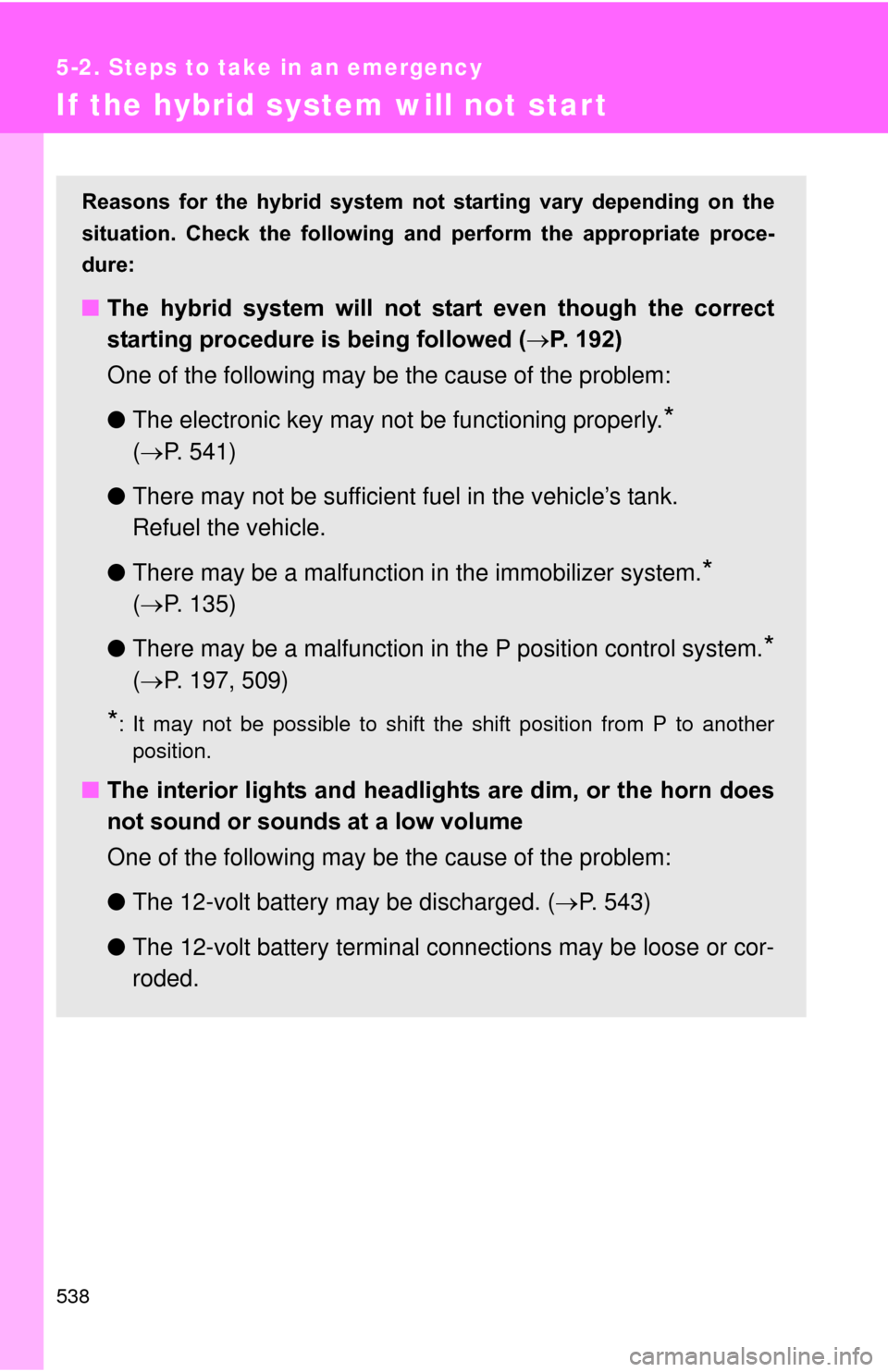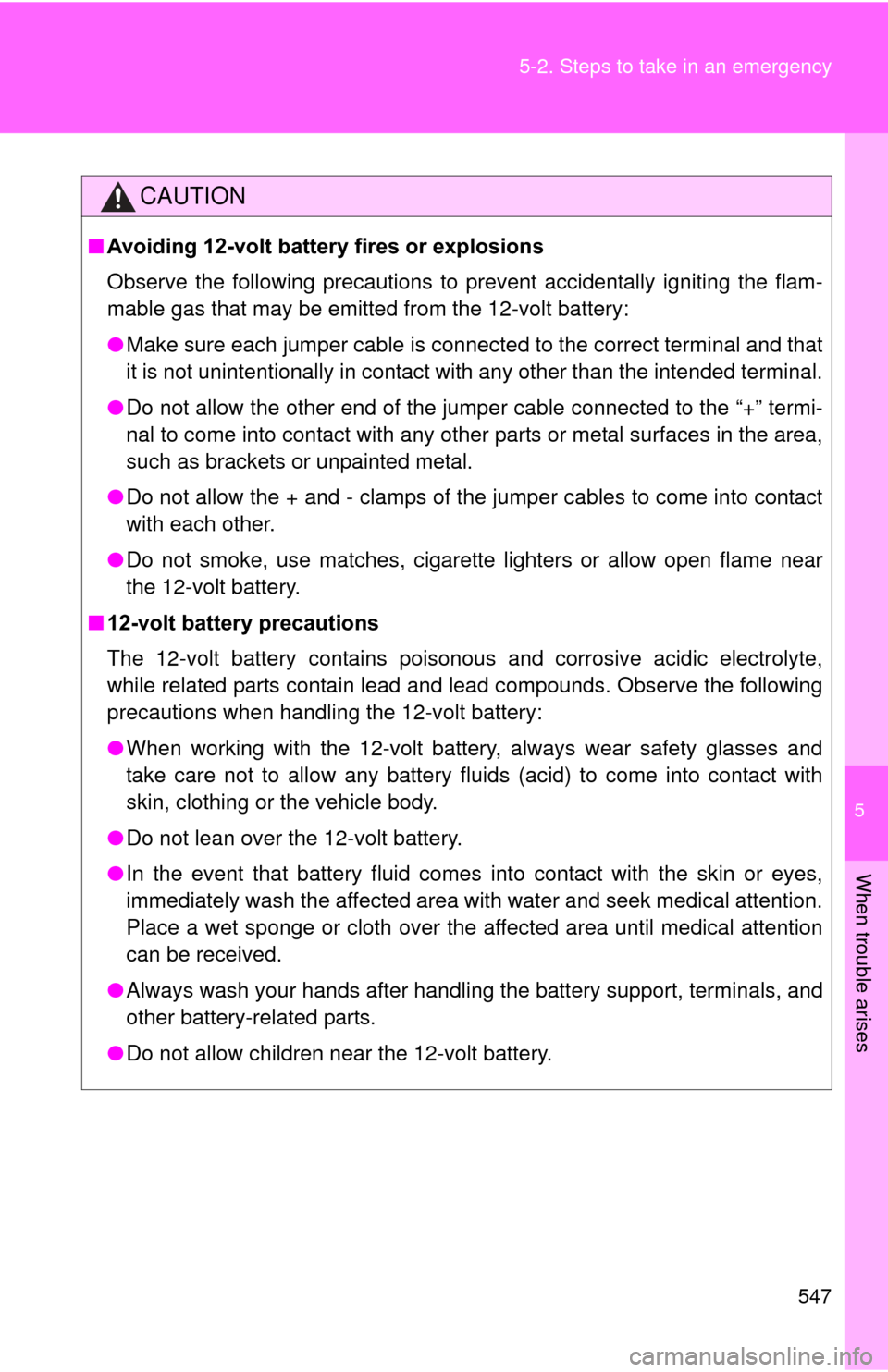Page 538 of 636

538
5-2. Steps to take in an emergency
If the hybrid system will not start
Reasons for the hybrid system not starting vary depending on the
situation. Check the following a nd perform the appropriate proce-
dure:
■ The hybrid system will not start even though the correct
starting procedure is being followed ( P. 192)
One of the following may be the cause of the problem:
● The electronic key may not be functioning properly.
*
( P. 541)
● There may not be sufficient fuel in the vehicle’s tank.
Refuel the vehicle.
● There may be a malfunction in the immobilizer system.
*
( P. 135)
● There may be a malfunction in the P position control system.
*
( P. 197, 509)
*: It may not be possible to shift the shift position from P to another
position.
■ The interior lights and headlights are dim, or the horn does
not sound or sounds at a low volume
One of the following may be the cause of the problem:
●The 12-volt battery may be discharged. ( P. 543)
● The 12-volt battery terminal c onnections may be loose or cor-
roded.
Page 539 of 636
5
When trouble arises
539
5-2. Steps to take in an emergency
Emergency start function
When the hybrid system does not start, the following steps can be
used as an interim measure to st art the hybrid system if the
“POWER” switch is functioning normally:
Set the parking brake.
Turn the “POWER” switch to ACCESSORY mode.
Press and hold the “POWER” switch for about 15 seconds
while depressing the brake pedal firmly.
Even if the hybrid system can be started using the above steps, the
system may be malfunctioning. Have the vehicle inspected by your
Toyota dealer.
■ The interior lights and headlights do not turn on, or the horn
does not sound
One of the following may be the cause of the problem:
●One or both of the 12-volt ba ttery terminals may be discon-
nected.
● The 12-volt battery may be discharged. ( P. 543)
Contact your Toyota dealer if the problem cannot be repaired, or if
repair procedures are unknown.
STEP 1
STEP 2
STEP 3
Page 545 of 636
5
When trouble arises
545
5-2. Steps to take in an emergency
Start the engine of the second vehicle. Increase the engine
speed slightly and maintain at
that level for approximately
5 minutes to recharge the battery of your vehicle.
Maintain the engine speed of the second vehicle and start
the hybrid system of your ve hicle by turning the “POWER”
switch to ON mode.
Make sure the “READY” indicator comes on. If the indicator
light does not come on, contact your Toyota dealer.
Once the hybrid system has started, remove the jumper
cables in the exact reverse or der from which they were con-
nected.
Close the exclusive jump starting terminal cover, and rein-
stall the fuse box cover to its original position.
When installing, first hook the fuse box cover onto the two rear
tabs.
Once the hybrid system starts , have the vehicle inspected at
your Toyota dealer as soon as possible.
STEP 4
STEP 5
STEP 6
STEP7
STEP8
Page 546 of 636

546 5-2. Steps to take in an emergency
■Starting the hybrid system when the 12-volt battery is discharged
The hybrid system cannot be started by push-starting.
■ To prevent 12-volt battery discharge
●Turn off the headlights and the audio system while the hybrid system is
off.
● Turn off any unnecessary electrical components when the vehicle is run-
ning at a low speed for an extended period, such as in heavy traffic.
■ When the 12-volt battery is removed or discharged
●The hybrid system may not start. ( P. 433)
● If the 12-volt battery is depleted with the shift position in P, it will not be
possible to shift the shift position other than P. In this case, the vehicle
cannot be towed without lifting both front wheels because the front
wheels are locked by the parking lock. ( P. 485)
● When the 12-volt battery is reconnected, start the hybrid system, depress
the brake pedal, and confirm that it is possible to shift into each shift posi-
tion.
■ Charging the 12-volt battery
The electricity stored in the 12-volt battery will discharge gradually even
when the vehicle is not in use, due to natural discharge and the draining
effects of certain electrical appliances. If the vehicle is left for a long time, the
12-volt battery may discharge, and the hybrid system may be unable to start.
(The 12-volt battery recharges automatically while the hybrid system is oper-
ating.)
Page 547 of 636

5
When trouble arises
547
5-2. Steps to take in an emergency
CAUTION
■
Avoiding 12-volt battery fires or explosions
Observe the following precautions to prevent accidentally igniting the flam-
mable gas that may be emitted from the 12-volt battery:
●Make sure each jumper cable is connected to the correct terminal and that
it is not unintentionally in contact with any other than the intended terminal.
● Do not allow the other end of the jumper cable connected to the “+” termi-
nal to come into contact with any other parts or metal surfaces in the area,
such as brackets or unpainted metal.
● Do not allow the + and - clamps of the jumper cables to come into contact
with each other.
● Do not smoke, use matches, cigarette lighters or allow open flame near
the 12-volt battery.
■ 12-volt battery precautions
The 12-volt battery contains poisonous and corrosive acidic electrolyte,
while related parts contain lead and lead compounds. Observe the following
precautions when handling the 12-volt battery:
●When working with the 12-volt battery, always wear safety glasses and
take care not to allow any battery fluids (acid) to come into contact with
skin, clothing or the vehicle body.
● Do not lean over the 12-volt battery.
● In the event that battery fluid comes into contact with the skin or eyes,
immediately wash the affected area with water and seek medical attention.
Place a wet sponge or cloth over the affected area until medical attention
can be received.
● Always wash your hands after handling the battery support, terminals, and
other battery-related parts.
● Do not allow children near the 12-volt battery.
Page 549 of 636
5
When trouble arises
549
5-2. Steps to take in an emergency
If your vehicle overheats
Correction procedures■ If the high coolant temperature warning light flashes or comes
on
Stop the vehicle in a safe place and turn off the air condition-
ing system.
Check to see if steam is coming out from under the hood.
If you see steam: Stop the hybrid system. Carefully lift the hood after the
steam subsides and then restart the hybrid system.
If you do not see steam: Leave the hybrid system operating and carefully lift the
hood.
The following may indicate that your vehicle is overheating:
●The high coolant temperature warn ing light flashes or comes on:
The engine may be overheating.
● “HYBRID SYSTEM OVERHEAT” is shown on the multi-informa-
tion display:
The power control unit may be overheating.
Follow the correction procedure as described below.
STEP 1
STEP 2
Page 550 of 636
550 5-2. Steps to take in an emergency
Check to see if the cooling fans are operating.
If the fans are operating: Wait until the high coolant temperature warning light goes
off and then stop the hybrid system.
If the fans are not operating: Stop the hybrid system immediately and call your Toyota
dealer.
After the hybrid system has
cooled down sufficiently, check
the engine coolant level and
inspect the cooling system for
leaks.
If necessary, add engine coolant
up to the “FULL” line.
Water can be used in an emer-
gency measure if engine coolant
is unavailable. (P. 566)
Have the vehicle checked at nearest Toyota dealer as soon as possi-
ble.
STEP 3
STEP 4
ITO52P130
STEP 5
Page 551 of 636
5
When trouble arises
551
5-2. Steps to take in an emergency
■
If “HYBRID SYSTEM OVERHEAT” is shown on the multi-infor-
mation display
Stop the vehicle in a safe place and turn off the air condition-
ing system.
Leave the hybrid system operating and carefully lift the hood.
Check if the cooling fans are operating.
If the fans are operating: Wait until “HYBRID SYSTEM OVERHEAT” disappears and
then stop the hybrid system.
If the warning light does not turn off, call your Toyota dealer.
If the fans are not operating: Stop the hybrid system immediately and call your Toyota
dealer.
After the hybrid system has
cooled down, check the power
control unit coolant level and
inspect the cooling system for
leaks.
STEP 1
STEP 2
STEP 3
STEP 4